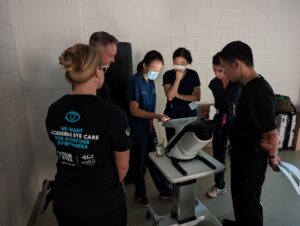What Providers Need To Know About Healthcare and Big Data Analytics

In today’s rapidly evolving technology-centric world, the healthcare industry faces numerous challenges, including the need for improved patient outcomes, cost-effective solutions, and efficient delivery of care. Because of this, big data analytics is emerging as a game-changer, providing a wealth of opportunities to address these challenges and revolutionize the healthcare industry altogether. By 2028, big data analytics in the healthcare sector could reach $79.2 billion, growing by 28.9% per year. By harnessing the power of innovative technologies in healthcare, big data analytics can help healthcare professionals and insurance providers alike make more informed decisions, leading to better care and improved overall patient health.

What is Big Data?
To put it simply, big data is a collection of vast amounts of information generated from different sources in various formats. Unlike traditional data, uncovering the insights hidden within big data is difficult because the information is often too vast and the technology at one’s disposal may not be sufficient.
Big data is classified by the three Vs: volume, velocity, and variety. Volume refers to the sheer amount of data that organizations collect. Velocity refers to the speed of receiving data and the rate at which it is utilized. Finally, variety refers to types of data. What separates big data from traditional data types is that it can come unstructured or semistructured, meaning it doesn’t fit in a traditional database and is more difficult to interpret. In healthcare, big data analytics often come from sources such as electronic health records, medical imaging, lab results, wearable health devices, and patient-reported data.
Because much of the data in healthcare comes unstructured at a quick pace, the importance of analyzing healthcare and big data analytics continues to grow.
The Growing Importance of Healthcare and Big Data Analytics
With the growing importance of data in healthcare, big data analytics can play a vital role in fostering more informed decisions based on data-driven insights, helping to achieve better patient outcomes. With big data, the more information you have, the better your choices are in treating patients. The better your choices are, the higher percentage of positive patient outcomes you have. An example of this is the Cancer Moonshot Program. This government-funded cancer prevention program has been running since 2016 intending to accomplish “ten years worth of progress toward curing cancer in half that time.”
In this program, medical researchers have used big data from cancer recovery plans and results to find cancer treatments with a high success rate. One of the unexpected outcomes of this program was the finding that the anti-depressant Desipramine could help cure particular types of lung cancer. As the program collects and analyzes an increasing amount of data, the impact on patient outcomes will become more significant and apparent.
Besides finding cancer treatments, healthcare and big data analytics have been used to detect diseases, personalize medical treatment plans, and enhance operational efficiency.
Key Applications of Healthcare and Big Data Analytics
Predictive Analytics for Early Disease Detection
With the help of natural language processing, sorting through big data and analyzing predictive analytics have been crucial to detecting diseases earlier than ever before. Through the use of big data in healthcare, providers can determine patients who are at risk for common chronic diseases like diabetes, COPD, and congestive heart failure. Determining which people are at risk comes from various factors including medical history, lab values, pharmaceuticals, comorbidities, and the socio-economic profile of the person.
Personalized Medicine and Tailored Treatment Plans
In this same vein, the use of big data in healthcare can help providers identify potential risk factors for patients and predict possible side effects from treatment. As a result, doctors and providers can use big data to target each patient’s unique needs, set up personalized health plans, and enhance the effectiveness of their treatment for better patient outcomes overall.
Enhancing Operational Efficiency
Along with patient data in healthcare, big data analytics can enhance operations in the healthcare sector. Most notably, by utilizing big data, healthcare providers can learn to spot bottlenecks, inefficiencies, and areas for improvement like scheduling, reducing wait times, and improving patient satisfaction overall.
However, using big data in healthcare isn’t as perfect as it seems. There are still some drawbacks to this new technology.

Overcoming Challenges With Healthcare and Big Data Analytics
One challenge of using big data in healthcare is the data privacy and security concerns that arise. Healthcare systems are tasked with protecting patient information while complying with the Health Insurance Portability and Accountability Act (HIPAA). Unfortunately, healthcare and big data analytics are still susceptible to having patient information stolen through data breaches and cyberattacks. Because of this, healthcare providers must ensure secure storage and transmission of data, authorized control access, and compliance with regulations by continuously updating privacy and security measurements.
Another challenge to consider is ensuring data accuracy and quality in big data. According to a study from 2020, 66% of leaders in Health Information Exchanges (HIE) believe that data entry errors contribute to duplicates in their health systems, which can be a detrimental source of uninformed medical decisions. With so much data present within healthcare, big data analytics may not always be 100% accurate. Thus, big data should not be used alone in making patient care decisions. However, it can be a helpful tool.
As technologies like artificial intelligence grow within healthcare, big data analytics will become more pertinent. By decreasing incorrect data entries and increasing the standardization of unstructured data, remote patient care and population health management will improve overall.
The Potential of Big Data in Healthcare
Telemedicine and Remote Patient Monitoring
In the future of healthcare, big data analytics will enhance patient care through remote patient monitoring and telemedicine. With wearable devices, remote monitoring systems, and telemedicine, providers will be able to proactively identify health concerns from patients based on the data they collected and tailor treatment plans for them. This too can help to identify early warning signs in patients and reduce emergency hospital admissions while eliminating the need for in-person care and reducing costs for both patients and providers.
Population Health Management
Along with remote monitoring in healthcare, big data analytics will be useful in improving patient care across populations by identifying risk factors based on patient demographics. By identifying the risk factors associated with these particular populations, providers can design campaigns, allocate resources, and drive the creation of public health policies that achieve better health outcomes for specific communities. The specific population characteristics that are often looked at to determine risk factors include age, gender, ethnicity, socioeconomic status, geographic location, and lifestyle factors.
Embracing Healthcare, Big Data Analytics, and Technology for a Transformative Impact
Big data will only continue to grow, and the need for technologies to improve and enhance the effectiveness of patient care will too. At IRIS, we are excited about the impact of big data analytics and other innovative technologies to help detect diabetic retinopathy and prevent the leading cause of blindness in adults. There is still immense untapped potential within big data analytics, and diabetic retinopathy screenings could benefit from these advancements.
Join IRIS in leading the charge in the fight against preventable blindness. The IRIS end-to-end solution provides access to quality testing and early diagnoses of diabetic retinopathy, ensuring better treatment for all and reducing the risk of sight loss in diabetic patients by 90%. Want to learn more? Contact us or read our case studies to see how hospitals, healthcare providers, and in-home health providers use the IRIS solution to improve patient care across the board.
Frequently Asked Questions
How Is Big Data Analytics Used in Healthcare?
Big data analytics in healthcare is used to identify patterns, predict outcomes, and optimize treatment plans for patients. Healthcare providers can harness large data sets to make data-driven decisions, enhance efficiency, and reduce costs.
How Is Big Data Used in Healthcare?
Big data in healthcare uncovers hidden patterns, correlations, and insights that inform patient care and resource allocation. By analyzing vast amounts of data, providers can enhance diagnostics, predict outcomes, and optimize treatment strategies for better patient outcomes.
What Are Examples of Big Data in Healthcare?
Examples of big data in healthcare include electronic health records (EHRs), medical imaging data, wearable device data, and genomic data. These sources provide valuable insights for diagnosing diseases, predicting patient outcomes, and creating personalized treatment plans.
What Are Three Use Cases for Big Data in Healthcare?
Predictive analytics for early disease detection, personalized medicine for tailored treatments, and resource optimization for efficient patient care are three use cases for big data in healthcare. These three enhance healthcare outcomes while reducing costs and improving patient experiences.
SM# 139, Rev A
Get started with IRIS today.
Want to know if IRIS is right for you? Schedule a one-on-one consultation with our team. We’re here to help.